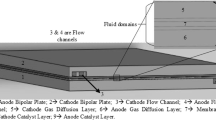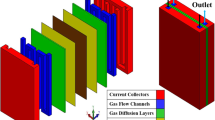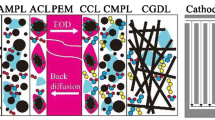Abstract
Adoption of hydrogen economy by means of using hydrogen fuel cells is one possible solution for energy crisis and climate change issues. Polymer electrolyte membrane (PEM) fuel cell, which is an important type of fuel cells, suffers from the problem of water management. Cross-flow is induced in some flow field designs to enhance the water removal. The presence of cross-flow in the serpentine and interdigitated flow fields makes them more effective in proper distribution of the reactants on the reaction layer and evacuation of water from the reaction layer than diffusion-based conventional parallel flow fields. However, too much of cross-flow leads to flow maldistribution in the channels, higher pressure drop, and membrane dehydration. In this study, an attempt has been made to quantify the amount of cross-flow required for effective distribution of reactants and removal of water in the gas diffusion layer. Unit cells containing two adjacent channels with gas diffusion layer (GDL) and catalyst layer at the bottom have been considered for the parallel, interdigitated, and serpentine flow patterns. Computational fluid dynamics-based simulations are carried out to study the reactant transport in under-the-rib area with cross-flow in the GDL. A new criterion based on the Peclet number is presented as a quantitative measure of cross-flow in the GDL. The study shows that a cross-flow Peclet number of the order of 2 is required for effective removal of water from the GDL. Estimates show that this much of cross-flow is not usually produced in the U-bends of Serpentine flow fields, making these areas prone to flooding.








Similar content being viewed by others
Abbreviations
- a, b:
-
Constants
- CRl :
-
Linear resistance coefficient
- df :
-
Fiber diameter, m
- Dij eff :
-
Effective diffusivity of component i in component j, cm2 s−1
- F:
-
Faraday’s constant, 96485 coulombs1 mole−1
- I:
-
Current, A
- K:
-
Permeability of the porous medium, m2
- kCK :
-
Carman-Kozeny constant
- Mi, Mj :
-
Molecular weight of the components i and j
- ni :
-
Number of electrons transferred in the reaction
- Nc :
-
Number of components in the mixture
- p:
-
Pressure, atm
- pc,i pc,j :
-
Pressure, atm
- Pe:
-
Peclet number
- Re:
-
Reynolds number
- Si :
-
Source term for each species in the catalyst layer
- SM :
-
Momentum source term
- Sc:
-
Schmidth number
- Tc,i Tcj :
-
Critical temperature, K
- Ti :
-
Temperature of component i, K
- V:
-
Velocity vector, m s−1
- V:
-
Volume of the fluid mixture, m3
- Vb,C, Vb,o :
-
Bulk volumes of the compressed and uncompressed samples, m3
- Vp,c :
-
Pore volume of compressed GDL, m3
- Yi :
-
Mass fraction of species i
- ρ:
-
Density, kg m−3
- <ρi>:
-
Material property of the component
- α:
-
Physical property
- µ:
-
Viscosity, kg m−1 s−1
- Ɛ:
-
Porosity of the porous material
- Ɛc, Ɛ0 :
-
Porosities of the compressed and uncompressed GDLs
- δ:
-
Kronecker Delta
- CFD:
-
Computational fluid dynamics
- CL:
-
Catalyst layer
- ECSSFF:
-
Enhanced cross flow split serpentine flow field
- GDL:
-
Gas diffusion layer
- IFF:
-
Interdigitated flow field
- PEM:
-
Polymer electrolyte membrane
- PEMFC:
-
Polymer electrolyte membrane fuel cell
- PFF:
-
Parallel flow field
- PTFE:
-
Polytetrafluoroethylene
- SFF:
-
Serpentine flow field
References
Arvay A, Yli-Rantala E, Liu CH, Peng XH, Koski P, Cindrella L, Kauranen P, Wilde PM, Kannan AM (2012) Characterization techniques for gas diffusion layers for proton exchange membrane fuel cells—a review. J Power Sources 213:317–337
Bachman J, Santamaria A, Tang HY, Park JW (2012) Investigation of polymer electrolyte membrane fuel cell parallel flow field with induced cross flow. J Power Sources 198:143–148
Bird RB, Stewart WE, Lightfoot EN (1960) Transport phenomena. John Wiley and Sons, New York
Carman PC (1956) Flow of gases through porous media. Butterworths, London
Cindrella L, Kannan AM, Lin JF, Saminathan K, Ho Y, Lin CW, Wertz J (2009) Gas diffusion layer for proton exchange membrane fuel cells—a review. J Power Sources 194:146–160
Feser JP, Prasad AK, Advani SG (2006) On the relative influence of convection in serpentine flow fields of PEM fuel cells. J Power Sources 161:404–412
Gostick JT, Fowler MW, Pritzker MD, Ioannidis MA, Behra LM (2006) In-plane and through-plane gas permeability of carbon fiber electrode backing layers. J Power Sources 162:228–238
Heidary H, Kermani MJ (2013) Performance enhancement of fuel cells using bipolar plate duct indentations. Int J Hydrog Energy 38:5485–5496
Iranzo A, Boillat P, Biesdorf J, Tapia E, Salva A, Guerra J (2014) Liquid water preferential accumulation in channels of PEM fuel cells with multiple serpentine flow fields. Int J Hydrog Energy 39:15687–15695
Jiao K, Li X (2011) Water transport in polymer electrolyte membrane fuel cells. Prog Energy Combust Sci 37:221–291
Kanezaki T, Li X, Baschuk JJ (2006) Cross leakage flow between adjacent flow channels in PEM fuel cells. J Power Sources 162:415–425
Mathias MF, Roth J, Fleming J, Lehnert W (2003) Diffusion media materials and Characterization. pp. 517–537. In. W. Vielstich, H.A. Gasteiger and A. Lamm (eds.), Handbook of fuel cells—fundamentals, technology and applications, vol. 3, Part 1, John Wiley & Sons, New York
Natarajan D, Nguyen TV (2001) A two-dimensional, two-phase, multicomponent, transient model for the cathode of a proton exchange membrane fuel cell using conventional gas distributors. J Electrochem Soc 148:A1324–1335
Oosthuizen PH, Sun L, McAuley KB (2005) The effect of channel-to-channel gas crossover on the pressure and temperature distribution in PEM fuel cell flow plates. Appl Therm Eng 25:1083–1096
Park J, Li X (2007) An experimental and numerical investigation on the cross flow through gas diffusion layer in a PEM fuel cell with a serpentine flow channel. J Power Sources 163:853–863
Park S, Lee JW, Popov BN (2012) A review of gas diffusion layer in PEM fuel cells: materials and designs. Int J Hydrog Energy 37(7):5850–5865
Park J, Oh H, Ha T, Lee Y, Min K (2015) A review of the gas diffusion layer in proton exchange membrane fuel cells: durability and degradation. Appl Energy 155:866–880
Peppley BA, Pharoah JG, Karan K, Harvey D, Hamilton D, Sun W (2005) Mechanistic modeling of PEM fuel cells: application to serpentine flow-fields. Proceedings of the European Fuel Cell Forum, Lucerne, B054-071
Santamaria AD, Becton MK, Cooper NJ, Weber AZ, Park JW (2015) Effect of cross-flow on PEFC liquid-water distribution: an in-situ high resolution neutron radiography study. J Power Sources 293:162–169
Shi Z, Wang X (2008) A numerical study of flow crossover between adjacent flow channels in a proton exchange membrane fuel cell with serpentine flow field. J Power Sources 185:985–992
Shyam Prasad KB, Jayanti S (2007) Multi-component formulation on water evacuation in interdigitated flow field. ASME conference on Fuel Cell Sci. Eng. Tec., New York, USA
Shyam Prasad KB, Jayanti S (2008) Effect of channel-to-channel cross-flow on local flooding in serpentine flow-fields. J Power Sources 180:227–231
Sun W, Peppley BA, Karan K (2005) Modeling the influence of GDL and flow-field plate parameters on the reaction distribution in the PEMFC cathode catalyst layer. J Power Sources 144:42–53
Sun L, Oosthuizen PH, McAuley KB (2006) A numerical study of channel-to-channel flow cross-over through the gas diffusion layer in a PEM fuel cell flow system using a serpentine channel with a trapezoidal cross-sectional shape. Int J Therm Sci 45:1021–1026
Suresh PV, Jayanti S (2010) Effect of air flow on liquid water transport through a hydrophobic gas diffusion layer of polymer electrolyte membrane fuel cell. Int J Hydrog Energy 35:6872–6886
Suresh PV, Jayanti S, Deshpande AP, Haridoss P (2011) An improved serpentine flow field with enhanced cross-flow for fuel cell applications. Int J Hydrog Energy 36:6067–6072
Taira H, Liu H (2012) In-situ measurements of GDL effective permeability and under-land cross-flow in a PEM fuel cell. Int J Hydrog Energy 37:13725–13730
Tong S, Bachman JC, Santamaria A, Park JW (2013) Experimental investigation on a polymer electrolyte membrane fuel cell (PEMFC) parallel flow field design with external two-valve regulation on cathode channels. J Power Sources 242:195–201
Um S, Wang CY (2004) Three-dimensional analysis of transport and electrochemical reactions in polymer electrolyte fuel cells. J Power Sources 125:40–51
Um S, Wang CY, Chen KS (2000) Computational fluid dynamics of proton exchange membrane fuel cells. J Electrochem Soc 147:4485–4493
Wang Y, Wang L, Advani GS, Prasad AK (2015) Double-layer gas diffusion media for improved water management in polymer electrolyte membrane fuel cells. J Power Sources 292:39–48
Williams MV, Kunz HR, Fenton JM (2004) Influence of convection through gas diffusion layers on limiting current in PEMFCs using a serpentine flow field. J Electrochem Soc 151:A1617
Yin Y, Wu T, He P, Du Q, Jiao K (2014) Numerical simulation of two-phase cross flow in microstructure of gas diffusion layer with variable contact angle. Int J Hydrog Energy 39:15772–15785
Zamel N, Li X (2013) Effective transport properties for polymer electrolyte membrane fuel cells—with a focus on the gas diffusion layer. Prog Energy Combust Sci 39:111–146
Author information
Authors and Affiliations
Corresponding author
Additional information
Responsible editor: Angeles Blanco
Rights and permissions
About this article
Cite this article
Suresh, P.V., Jayanti, S. Peclet number analysis of cross-flow in porous gas diffusion layer of polymer electrolyte membrane fuel cell (PEMFC). Environ Sci Pollut Res 23, 20120–20130 (2016). https://doi.org/10.1007/s11356-016-6629-x
Received:
Accepted:
Published:
Issue Date:
DOI: https://doi.org/10.1007/s11356-016-6629-x




